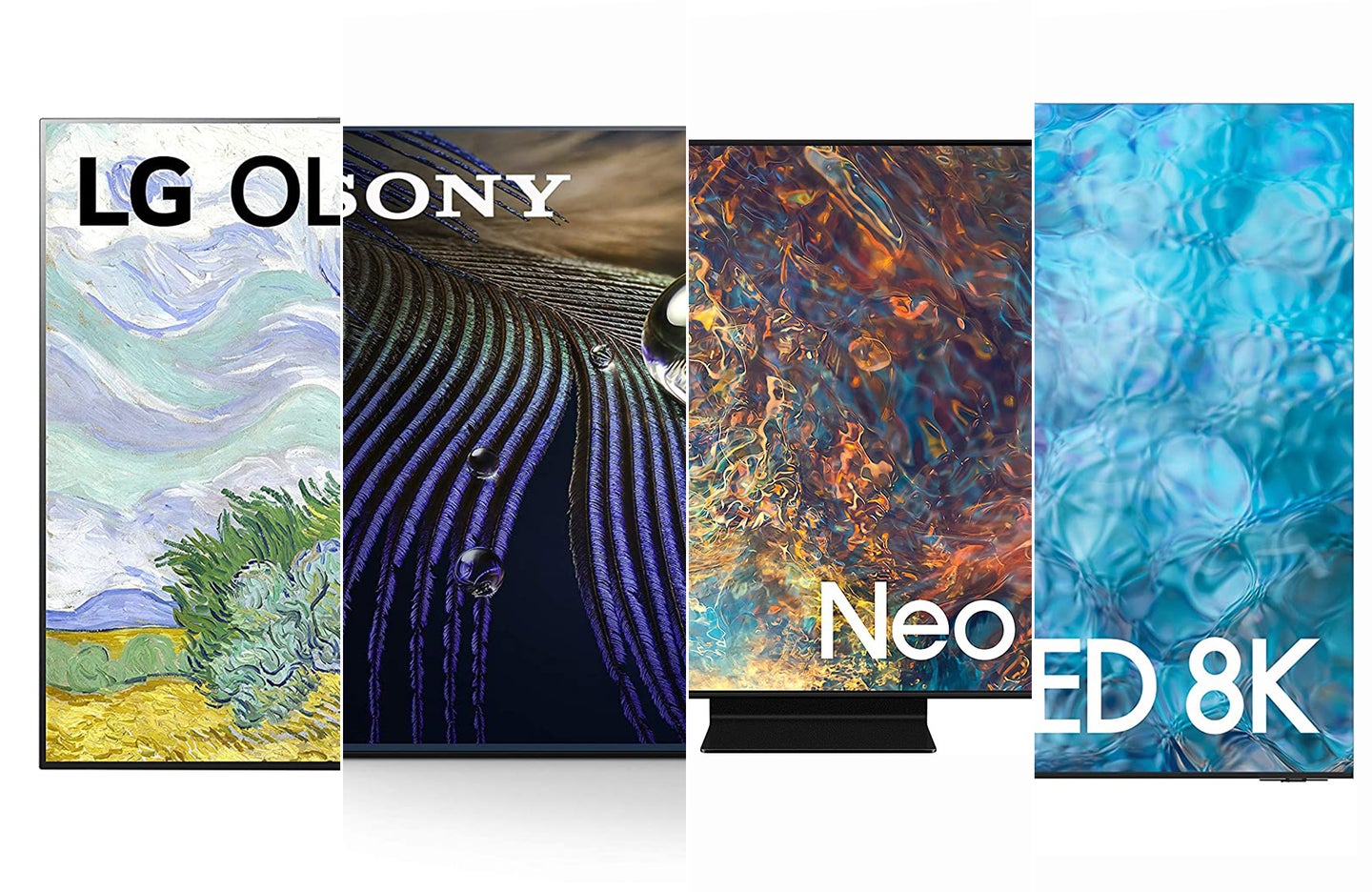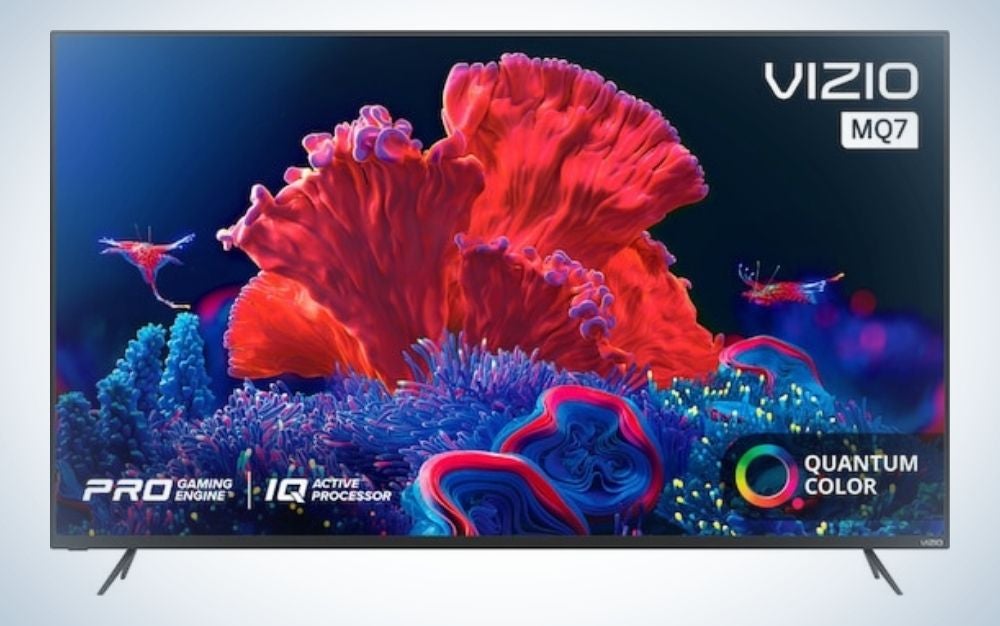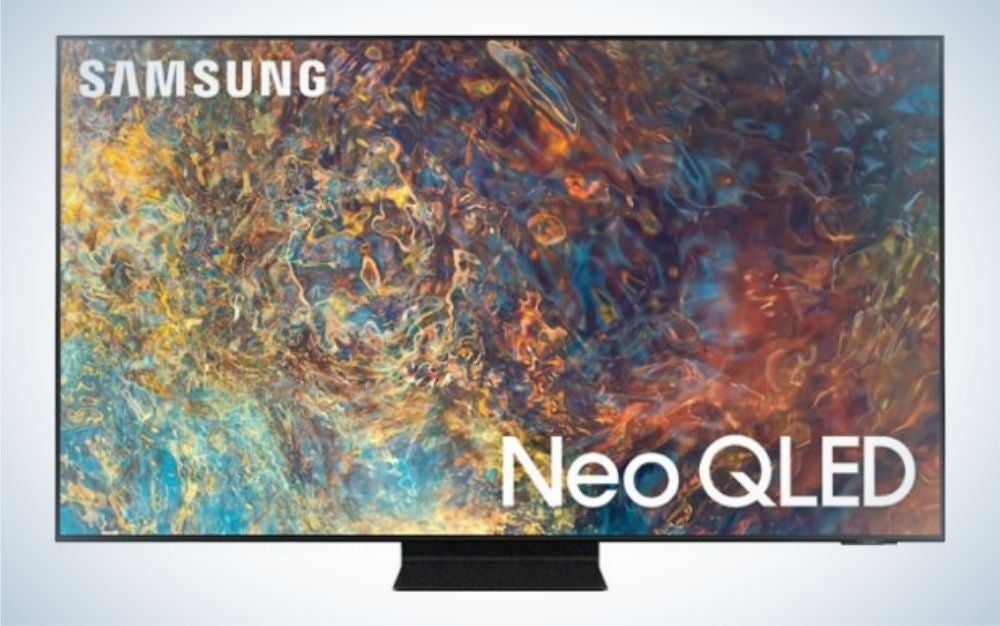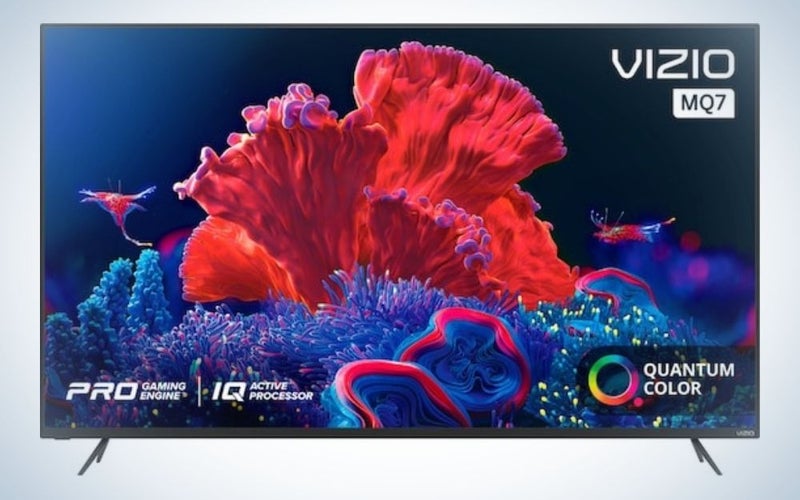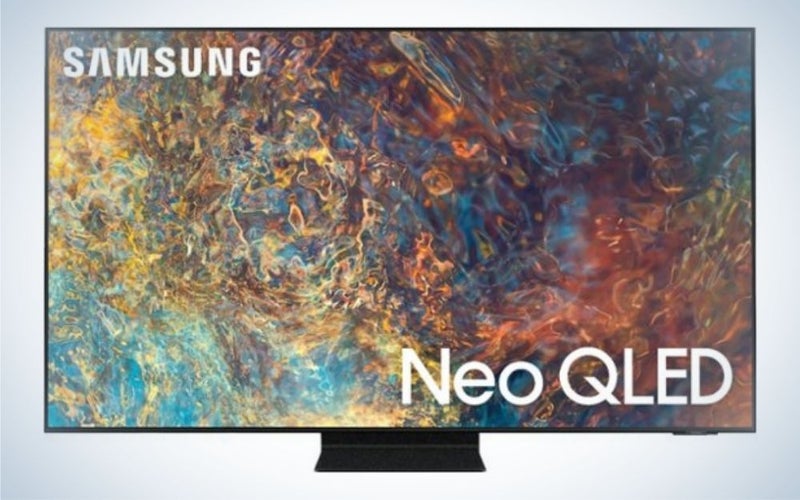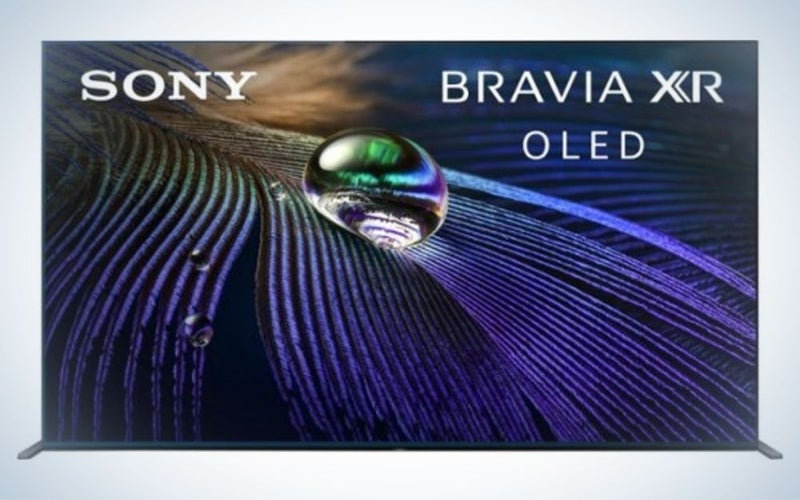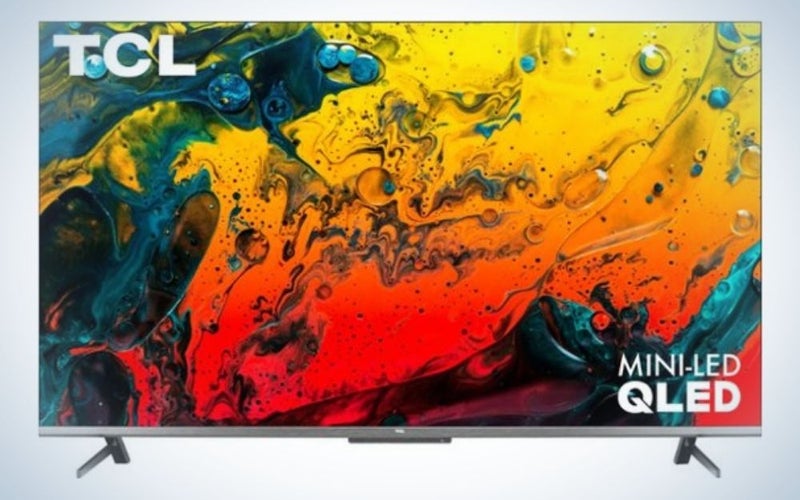We may earn revenue from the products available on this page and participate in affiliate programs. Learn more ›
They say go big or go home, and when it comes to TVs that saying couldn’t be any more appropriate. If you have the space, a 65-inch TV offers an immersive, make-your-neighbors-jealous home theater experience. With new gaming consoles available and so much streaming content at our disposal, finding the right TV is more important than ever. If you’ve measured your living room and know that a 65-inch big screen is the right size for you, you’re in luck: We have a list of the best 65-inch TVs to make your living room pop.
- Best overall: LG G1
- Best budget: Vizio MQ7
- Best TV for gaming: Samsung QN90A
- Best 8K TV: Samsung QN900B QLED 8K
- Best OLED TV: Sony Bravia XR Master Series A90J OLED
- Best QLED TV: TCL 6-Series Google TV (R646)
How we picked the best 65-inch TVs
I’ve been writing about consumer electronics for over a decade for sites like TechnoBuffalo, XDA Developers, iMore, and Android Central, and I’ve gotten my hands (and eyes) on a lot of different TVs. I’ve also been known to go to Best Buy to stare at the wall of TVs, just because that’s what I like to do in my free time. When I’m not writing about tech on the internet, I’m probably watching a movie or gaming, so having a great screen is very important to me.
When rounding up my picks, I drew on my experience and also considered what I think is important when picking a TV. That means finding a healthy balance between features, price, and technology. Since we’ve entered a new era of gaming, one of the most important considerations was whether these TVs have HDMI 2.1 or not. Only one of our picks doesn’t, but we still think it’s an excellent set.
The best 65-inch TVs: Reviews & Recommendations
When coming up with our list of best 65-inch TVs, we tried to find something that fit a variety of different needs and price ranges. If you decide to purchase such a large TV, you’re making a big commitment—literally—so make sure your choice fits your criteria. Me? My biggest consideration is for gaming; I don’t own an Xbox Series X or PlayStation 5 but one day I will, which means I’ll want the unit I buy to support all the latest HDMI 2.1.
Best 65-inch TV (overall): LG G1
LG
Why it made the cut: The LG G1 has the ports, the picture quality, and the features to make it our pick for most well-rounded.
Specs
- Resolution: 4K
- Refresh rate: 120Hz
- Ports: HDMI 2.1 x 4, USB 2.0 x 3, Ethernet, headphone jack
Pros
- Excellent picture
- Well-rounded features
- Sleek design
Cons
- Doesn’t come with a stand
- Expensive
The LG G1 consistently ranks among the best TVs on the market and we have to agree. It features a terrific OLED picture with incredible contrast and color. What’s most striking about the LG G1 is how well it balances features, price, and performance. In addition to supporting FreeSync and G-Sync variable refresh rate technologies, it offers four HDMI 2.1 ports that all support 4K 120Hz, a Filmmaker Mode that turns off motion smoothing and tones down the vibrance and brightness, and other low-latency options.
The LG G1 also features support for Google Assistant and Amazon Alexa, depending on your preference, as well as support for Apple’s AirPlay 2, which means you can easily share photos and video to the TV from your iOS or macOS device. All of these features combine to a great overall pick, whether you’re watching a movie, sports, or playing games.
Best budget TV: Vizio M7 Quantum
VIZIO
Why it made the cut: The Vizio M7 Quantum includes support for Dolby Vision and FreeSync technology, and comes with AirPlay and Chromecast built-in—all at an affordable price.
Specs
- Resolution: 4K
- Refresh rate: 60Hz
- Ports: HDMI 2.0 x 4, USB 2.0, Ethernet, headphone jack
Pros
- Affordable
- Built-in Apple AirPlay and Chromecast support
- HDR10+ and Dolby Vision
Cons
- Not great for gaming
- Only 60Hz
The Vizio M7 Quantum comes equipped with so many features it’ll make your head spin: FreeSync, Dolby Vision HDR, plus AirPlay and Chromecast built-in, just to name a few. At such an affordable price, it almost feels like you’re getting away with something. Best of all, it features one heck of a picture.
So, what’s the catch? If you’re a gamer, you may want to avert your eyes. While the Vizio M7 Quantum sports a QLED panel, it doesn’t support 120Hz refresh rate. Its 600 nits of brightness are also lower than other top models on the market, impacting its capacity to take advantage of High-Dynamic Range, a feature that creates dynamic brightness. That said, it offers many of the features we look for in a great TV at a far lower price than most of our other picks.
Best TV for gaming: Samsung QN90A Neo QLED
Samsung
Why it made the cut: Samsung’s QN90A Neo QLED boasts impressive image quality and an elegant design.
Specs
- Resolution: 4K
- Refresh rate: 120Hz
- Ports: HDMI 2.1 x 3, HDMI 2.0 x 1, USB 2.0 x 2, Ethernet, headphone jack
Pros
- Thin, gorgeous design
- Game-specific enhancements
- Low input lag
Cons
- No Dolby Vision HDR
- Only one HDMI 2.1 port
Samsung’s QN90A is an incredibly bright, vibrant TV for gaming. The QLED panel supports quantum matrix technology and produces a bright, vibrant picture with excellent color reproduction, and a variety of smart features powered by Samsung’s Tizen platform.
The QN90A also features what it calls an “ultra viewing angle” mode, which promises a good viewing experience even when you’re sitting off to the side. And it also offers a Filmmaker Mode, which essentially provides users with what the TV thinks is the most accurate image. That means the full contrast ratio will be preserved, so blacks are deep and whites are bright (but not blown out).
Most importantly, the QN90A supports HDMI 2.1 features, including 4K at 120Hz, and an automatic low-latency mode. Additionally, it includes AMD FreeSync the aforementioned Game Bar interface, which allows users to adjust screen ratio, FPS, HDR, and more.
Best 8K TV: Samsung QN900B 8K
Samsung
Why it made the cut: There isn’t much 8K content available right now, but Samsung’s QN900B will make sure you’re ready when that day comes.
Specs
- Resolution: 4K
- Refresh rate: 120Hz
- Ports: HDMI 2.1 x 2, HDMI 2.0 x 2, USB 3.0 x 1, USB 2.0 x 1, Ethernet
Pros
- 8K resolution
- Four HDMI 2.1 ports
- FreeSync and G-Sync compatibility
Cons
- Expensive
- Not much 8K content available
Sure, you can brag to your friends if you own an 8K TV, but it’s not really something you can take advantage of very much right now, if at all. If you do want to flex your wallet more than improve your viewing experience, however, the Samsung QN900B is the best QLED 8K TV out there.
That said, even without access to 8K, the QN900B is still an impressive TV. With HDR10+, Game Mode enhancements, and four HDMI 2.1 ports, it has everything you need for a top-flight gaming experience … if you’re willing to pay $3,200. It also features anti-reflection and Ultra Viewing Angle technology, Wi-Fi 6 support, and Filmmaker Mode for the best possible experience when watching movies. At this point, buying in on 8K feels like making a bet that the future will arrive sooner rather than later. If you want to roll the dice, this is your best bet.
Best OLED TV: Sony Bravia XR Master Series A90J
Sony
Why it made the cut: With eye-popping picture quality, support for Google TV, and Dolby Atmos and Dolby Vision, the Sony A90J is hard to beat.
Specs
- Resolution: 4K
- Refresh rate: 120Hz
- Ports: 4 HDMI 2.1, Ethernet, Composite, RF, Headphone jack, 3 USB 2.0
Pros
- Fantastic picture quality
- Support for the latest HDMI 2.1 features
- Google TV onboard
Cons
- Expensive
The Sony A90J is the kind of TV you’ll look at and involuntarily gasp with glee. It features one of the most impressive OLED pictures on the market, offering deep black levels and exceptionally bright highlights. The A90J features an image processor that analyzes the on-screen image and audio to optimize the TV’s performance. That means you’ll get a little extra oomph during your viewing experience. And who doesn’t want a little oomph?
It features a bevy of software features, too. The Sony A90J supports Dolby Atmos and Dolby Vision, Google TV and built-in Chromecast functionality, and a native refresh rate of 120Hz. If you own an Xbox Series X or PlayStation 5, you’ll be happy to know Sony’s TV has two HDMI 2.1 ports that feature Variable Refresh Rate, Auto Low Latency Mode, and 4K at 120fps. In other words, games will look amazing.
Best QLED TV: TCL 6-Series Google TV (R646)
TCL
Why it made the cut: The TCL 6-Series supports the latest HDMI 2.1 features and a great picture at an excellent price.
Specs
- Resolution: 4K
- Refresh rate: 120Hz
- Ports: HDMI 2.1 x 2, HDMI 2.0 x 2, USB 2.0 x 2, Ethernet, Headphone jack
Pros
- Affordable
- Great picture quality for the price
- Support for 4K 120Hz
Cons
- With three models, it can get a little confusing
By offering affordable TVs with great picture quality and robust features, TCL has become one of the most popular manufacturers over the last few years. The TCL Class-6 Series QLED effortlessly upholds that reputation.
Here’s where it gets a little tricky: The TCL 6 Series comes in three models—a 4K version with Roku TV, a 4K version with Google TV, and an 8K version. We generally recommend the Google TV version, which is slightly newer and has a few upgrades over the Roku model, including two HDMI 2.1 ports. If you don’t care much about gaming, the Roku TV version is also a great choice.
Either way, the TCL 6-Series will treat you well, offering everything from HDR10+ to Dolby Vision. It also offers proper support for AirPlay 2 and Chromecast, VRR and auto low-latency, and 4K 120Hz gaming at a comparatively affordable price.
Things to consider before buying the best 65-inch TVs
Since we’re talking about a specific size of TV, the main thing you need to ask yourself is whether you actually have the space necessary to properly accommodate a 65-inch TV in your space. It’s important not to let your eyes get bigger than your stomach when you’re making your purchase. Despite the fact that bigger always seems better, cramming a large TV into a small room can make your space feel even smaller. Sitting too close to a big TV can also be bad for your eyes. The bottom line: An overly large screen can kill the excitement of your shiny new TV. I once bought a TV that I realized was far too big for the space I was in, so I returned it. It basically took up an entire wall and made our living room feel tiny. In the end, I was more realistic with the space I have and chose a size that was much more fitting. (With that in mind, I have thoughts on the best 55-inch TVs.)
Once you purchase a 65-inch TV, it’s recommended you sit about 9 feet away for the optimal viewing experience. That recommendation isn’t an exact science since everyone’s eyesight is different, but this calculator goes into much more detail about the optimal viewing distance depending on the size of your TV.
Assuming you have space, picking a size is only the first step. When picking a TV, you’ll want to consider screen technology (OLED or QLED), price, and a wide array of specs—from technical measurements of color and contrast to utilitarian concerns like the number of HDMI ports they have for gaming consoles, streaming set-top boxes, and other gadgets. It’s also important to consider things like refresh rate, resolution, and Smart TV features.
QLED vs OLED
Before you go any further, it’s important to know the differences between OLED and QLED. Despite the fact that their acronyms sound similar, they’re actually quite different and offer different benefits and technology.
Organic light-emitting diode, or “OLED,” displays feature a large number of independently controlled LEDs that illuminate each pixel on the screen. Because the lights can turn off completely, OLED screens have the ability to create “perfect” blacks, without any light bleeding through. They also create the sharpest possible contrast and have incredibly vibrant colors. OLED TVs look particularly impressive when displaying scenes with really challenging light, like when darkness is next to bright light. Older LED TVs have a tendency to “spill” light into shadows and areas with no light, whereas OLED TVs can handle those situations much better.
QLED stands for “quantum dot light-emitting diode.” QLED panels are a hybrid of traditional LCD and LED displays. Created by Samsung, QLED TVs use a traditional LED-backlit LCD panel but with an extra “transmissive” layer of “quantum dots” that enhance the screen’s color, brightness, and contrast. High-end QLED displays are often combined with Mini-LED backlighting, which can approximate an OLED panel’s enhanced contrast, though not quite as well.
For deeper dives on OLED and QLED technology, check out the explainers in our lists of the best OLED TVs and Best QLED TVs, which describe the tech in more detail.
Resolution
Almost all new TVs support 4K resolution, or 3840 x 2160p, which is great because that’s exactly what you want right now. Both streaming services and game consoles like the PS5 and Xbox Series X offer 4K content. if you’re upgrading from a 1080p TV, well, your eyes are in for a treat, because the step-up should make your TV look quite a bit sharper. There are some 8K TVs on the market, but there isn’t a whole lot to watch. Sure, buying an 8K TV will ensure you’re well prepared for the future, but there will likely be better 8K TVs out there by the time you’re actually ready to buy one.
Refresh rate
Refresh rate is an important feature for playing games and watching sports. Refresh rate refers to how many times your TV can redraw the on-screen image each second. A higher refresh rate—120Hz and above—will provide users with smoother on-screen motion. TVs typically feature 60Hz refresh rates, which is fine for most content. But a 120Hz TV can smooth out the animation of modern video games and improve the fluidity of the action in sports.
If gaming is what you care about most, we have recommendations for the best TV for gaming, where we take a deeper dive into refresh rates and why it’s important for gaming.
HDMI 2.1
You also want your TV to be future-proof, which means you’ll need a set with the right ports to get the most of your various gadgets, including the PlayStation 5 and Xbox Series X that you may or may not already have.
Most devices that plug into a TV connect via HDMI port. The thing is, not all HDMI ports (or HDMI cables) are created equal. The newest HDMI standard, HDMI 2.1, allows for higher resolutions and faster refresh rates. Only TVs made in the last two years have HDMI 2.1 and not all 2021 and 2022 TVs have them. Right now, you need an HDMI cable to watch TV at 4K resolution with a 120Hz frame rate. It’s also necessary to watch in 8K. You’ll notice that many sets have both HDMI 2.1 and HDMI 2.0 ports. Your next TV must have at least one HDMI 2.1 port but, in a perfect world, it should have two or more.
Smart TV features
In 2022, most TVs are smart TVs. They have streaming apps like Netflix, Hulu, and Amazon Prime Video baked right in. Different TVs use different operating systems, like Roku and Google TV, to serve those apps, which means you’ll get a vastly different user experience depending on the TV you choose. Personally, I would use an external set-top box that runs the platform of your choice, because they’re often much faster than what’s baked into a TV.
FAQs
Q: What size room do I need for a 65-inch TV?
As we mentioned above, the recommended viewing distance for a 65-inch TV is roughly 9 feet. That’s for the best possible experience. If you have to sit closer or farther, your experience may not be as enjoyable. Sit too close and you may put strain on your eyes. Sit too far and you may not be able to process details as well.
You also want to consider how a 65-inch TV looks in your room. Try taping off a section on your wall to get an idea of how much room the TV will take up. An oversized TV can make your living room feel small. A space that once felt open and inviting might suddenly feel cramped with a 65-inch TV tucked inside.
Q: Is OLED or QLED better?
As we explained in our roundup of best QLED TVs, there are pros and cons to both OLED and QLED TVs. OLED TVs have generally become the critic’s display of choice because they can independently control the brightness of every point on the screen, allowing you to get incredible contrast and true blacks. There are two main issues with OLED TVs: First, it’s a new and expensive technology. Second, they can suffer from burn-in, which can leave a permanent impression on your screen if an image is left on for too long.
While QLED TVs don’t quite achieve the same levels of contrast and color in most cases, they can be less expensive because it is a variation on older LCD and LED technologies (though the best of them get just as pricey). According to Samsung, the original creator of the QLED panel, they are also impervious to burn-in.
So, which is better? That’s up to you. OLED TVs technically offer the best pure picture quality. The best QLED panels can come close though, and are offered at more affordable prices.
Q: Which brand TV set is best?
Ask 10 different people and you’ll probably get 10 different answers. Companies like LG, Sony, and Samsung have dominated the TV space for years. But upstarts like Vizio, Hisense, and TCL have made good headway over the years, making them more competitive against their larger contemporaries.
Q: How long will an OLED TV last?
OLED TVs should have a lifespan of about 10 years, although your mileage may vary depending on how much you use it. If you watch a few hours of content per night, you should expect plenty of longevity. But if your OLED TV is on for several hours per day, it may degrade faster.
Q: Is 65 inches too big for 4K?
A 65-inch TV is absolutely not too big for 4K.
Final thoughts about the best 65-inch TVs
Does bigger actually mean better? In the world of TVs, the answer is often yes. The purpose of a TV is to watch content and play games. If you have a larger viewing area to enjoy that content, then, in my opinion, you’ll have a more enjoyable experience.
The good news is there are a lot of really great options available in this size range. It’s just a matter of paying attention to the details: How many HDMI 2.1 ports are there? What’s the refresh rate? What Smart TV features does it offer? There are options out there for everyone, and the ones mentioned above are some of the best.
